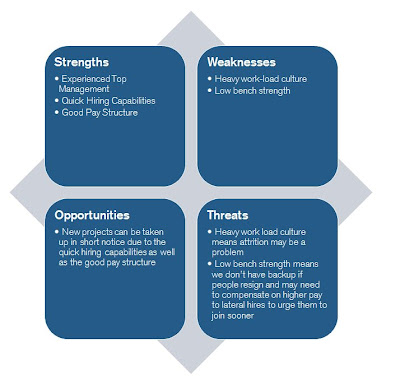In the previous chapters we took a look at the various diagramming techniques we utilize to identify risks. In this chapter we are going to learn about a technique that is extremely common and crucial in identifying the Organization level risks that may affect our project along with project level risks.
SWOT stands for:
S – Strengths
W – Weaknesses
O – Opportunities
T – Threats
SWOT Analysis intends on analyzing your project and organization from each of these perspectives to widen the reach of risk identification. SWOT Analysis typically goes through the following steps:
1. Identify Org/Project Strengths and Weaknesses
2. Identify Opportunities that arise as a result of the strengths
3. Identify Threats that arise as a result of the weaknesses
4. Examine the degree to which the strengths can offset the weaknesses
Practically speaking, these steps are done using a brainstorming session but let me add a caution here that, this brainstorming session is totally different than the one that we saw a few chapters ago. The purpose of that session was to identify project risks alone. The purpose/scope of this analysis/brainstorming is far wider than that. The main difference is that SWOT analysis can help uncover those risks that are generated internally within the organization along with the other project risks you may uncover from other areas of risk analysis and identification.
Look at the sample SWOT Analysis result below:
The Organization has many strengths like an experienced top management, quick hiring capabilities and a good pay structure. So, as a result of these strengths an opportunity is that, whenever a new project is to be taken up in short notice, the organization can do it because they have the capability to hire people quickly…
On the downside, the organization follows a heavy workload working culture along with low bench strength. So, the threats here are “Attrition possibilities” which is very common in high-pressure working culture environments. If attrition happens in a high scale, the organization may have to increase their pay packages in order to attract lateral hires at a faster rate.
Prev: Influence Diagrams
Next: Other Tools & Techniques we can use in Risk Identification









No comments:
Post a Comment